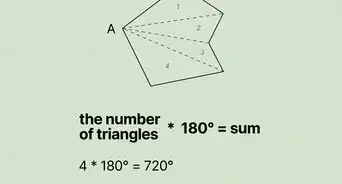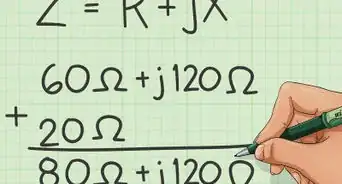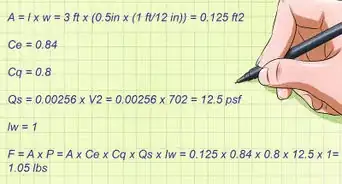wikiHow is a “wiki,” similar to Wikipedia, which means that many of our articles are co-written by multiple authors. To create this article, 11 people, some anonymous, worked to edit and improve it over time.
This article has been viewed 151,214 times.
Learn more...
When light passes through a surface, the straight beam of light is bent. The beam travels through the object along a different path than the beam was following when it entered the object. The beam of light bends again when it leaves the object. These bends at the surface boundaries between air and the object are called refraction. Refraction is caused by the fact that light travels at a constant speed only in a vacuum. When light passes through another object, the light is slowed down. The bend caused by this slowing can be calculated based on the refractive index of the object. The refractive index of an object is the ratio of the speed of light in a vacuum to the speed of light in the object.[1] Use these tips to learn how to calculate the refractive index in physics.
Steps
Determine the Measurements Needed For the Calculation
-
1Measure the width of the transparent object. For example, a pane of window glass has a thickness that may be stated by the manufacturer, but which should be measured to ensure accurate calculation of the refractive index.
-
2Send light from a point light source through the object. Monochromatic point light sources are available through laboratory supply outlets. Place the point light source a known distance from the surface of the object. Aim the point light source into the object perpendicularly to the point on the object being struck. Mark the other side of the object at the point where the light emerges.[2]Advertisement
-
3Aim the point light source into the object at an angle. Move the light source such that a line drawn between the perpendicular placing of the light source and the angled placing of the light source forms a right angle. Note the point where the light emerges on the other side of the object. Mark that point where the light emerges.[3]
Calculate the Angle Of Refraction
-
1Define a right triangle for the light in air. The first leg will be the distance that the point light source was placed from the object to make the perpendicular. The second leg will be the lateral distance that the point light source was moved from the perpendicular generation point to the angled generation point. The third leg, the hypotenuse, can be determined as the square root of the sum of the squares of the other 2 sides.[4]
-
2Create a right triangle for the light in the object. The first leg will be the thickness of the object. The second leg will be the distance between the 2 marks on the back of the object. The third leg, the hypotenuse, is defined as the square root of the sum of the squares of the other 2 sides.[5]
-
3Figure the angles. Knowing the dimensions of the triangles, the angles at the boundary between the air and the surface of the object can be calculated using trigonometry. The angle on the air side of the interface is the angle of incidence. The angle on the object side of the interface is the angle of refraction.[6]
-
4Calculate the refractive index. The refractive index of the object is the sine of the angle of incidence divided by the sine of the angle of refraction.[7]
Community Q&A
-
QuestionWhy do I need to read physics?
 Community AnswerPhysics is an important concept in life, and learning physics can explain the causes of phenomenons that are happening around you all the time. Also, the history of important scientists in physics can be both inspiring and informative.
Community AnswerPhysics is an important concept in life, and learning physics can explain the causes of phenomenons that are happening around you all the time. Also, the history of important scientists in physics can be both inspiring and informative. -
QuestionI'm not sure about the angle in air, I always thought it was the angle alternate to the one indicated here. Is this accurate?
 Community AnswerGenerally, we consider the angle made by the refracted ray with the normal. The angle shown here is equal to it, so it's accurate.
Community AnswerGenerally, we consider the angle made by the refracted ray with the normal. The angle shown here is equal to it, so it's accurate. -
QuestionHow do I make a virtual image refraction math problems for physics?
 Sarthik GargCommunity AnswerWe need to place the object at distance less than focus for a concave mirror and convex lens; convex mirror and concave lens always gives virtual image.
Sarthik GargCommunity AnswerWe need to place the object at distance less than focus for a concave mirror and convex lens; convex mirror and concave lens always gives virtual image.
Things You'll Need
- Point light source
References
- ↑ https://www.bbc.com/bitesize/guides/z88dd2p/revision/1
- ↑ https://www.lehman.edu/faculty/dgaranin/Introductory_Physics/Online%20labs/Experiment_17-Refraction-online.pdf
- ↑ https://www.omnicalculator.com/physics/index-of-refraction
- ↑ http://www.brooklyn.cuny.edu/bc/ahp/CellBio/RefIndex/RI.Main.html
- ↑ http://www.brooklyn.cuny.edu/bc/ahp/CellBio/RefIndex/RI.Main.html
- ↑ https://www.lehman.edu/faculty/dgaranin/Introductory_Physics/Online%20labs/Experiment_17-Refraction-online.pdf
- ↑ https://www.omnicalculator.com/physics/index-of-refraction
About This Article
Refraction occurs when a beam of light bends at the surface boundary between air and the object that it passes through. The refractive index of an object is the ratio of the speed of light in a vacuum to the speed of light in the object. To calculate the refractive index, start by measuring the width of the transparent object. Next, send light from a point light source through the object perpendicularly. You’ll also need to aim the point light into the object at an angle. Then, define a right triangle for the light in the air and another one for the light in the object, and find the sine of each angle. The refractive index is equal to the sine of the angle of incidence divided by the sine of the angle of refraction To learn how to use trigonometry to find the angles of the triangles, keep reading!
































































